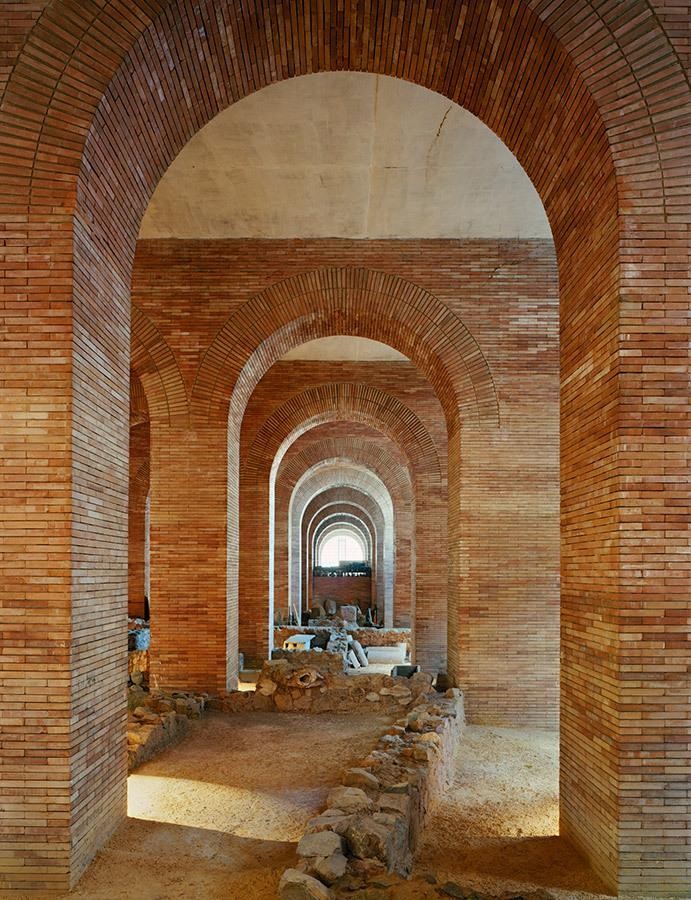
National Museum of Roman Art by Rafael Moneo – RTF
[ad_1]
Design concept and influence
The National Museum of Roman Art was founded by Dionisio Hernandez Gil who was in the Directorate General of Fine Arts along with Javier Tussell. The museum was constructed as a result of archaeologists finding an important piece from Roman times. When archaeologists were working on a retaining wall on Calle Jose Ramon Melida, they excavated a whole block to discover various Roman architectural elements like the aqueducts, foundations of Renaissance courtyards, peristyles of Roman houses, sewage pipes, remains of an early church, etc. The task given was to build a museum on an already-built structure. To safeguard these excavations, the team had to come up with an idea that did not interfere with the ancient architectural findings. The museum had to be built in a way that it coexisted with the beautiful ruins of the past. Using Roman construction techniques was an answer to preserve the ruins.


However, the construction was not as easy because there were conflicts within the site. The construction of the new museum became a bridge between Roman culture and present-day Merida. It became a symbol that represented the old city of Roman and present-day Merida. Although the planners planned to use Roman construction techniques, the architectural mechanisms used were contemporary. It ensured harmony between both which made the museum even more attractive.
Rafael’s approach to design the museum
Rafael Moneo, the Spanish architect who planned the structure of the National Museum of Roman Art studied the building and proposed that the building was a by-product of typology. This means that when the building is looked at, it gives an impression of a Roman type. The facade of the building is respectful to the Roman architecture but it does not overpower the neighbouring Roman ruins. Merida was once the Roman capital of the Spanish region and is now a city thriving to revive the city’s heritage. The museum has the largest collection of artifacts ( ORNELAS, 1995).

Moneo planned the project and divided it into two buildings, one part being the museum and the warehouses where the artifacts were to be stored, and the other part being workshops, administration, offices, libraries, etc. The museum which was supposedly to be the “type” building consisted of a series of bays parallel that ran perpendicular to the main space along with the main nave. The building was naturally lit up by placing the light filter on the central part of the ceilings running along the plan throughout (Cefalo).
The lighting was controlled using the design elements of the walls such as vertical ornaments and diaphragm walls of the nave at the southern end. The northern part had an ample amount of direct sunlight which lit up the adjacent spaces. The system of bays that Moneo used in the National Museum was reinforced further using a superimposed lattice structure that gave visitors a sense of hierarchy. Thus becoming a part of the architecture of the museum (Cefalo).

The artifacts present in the museum heavily dominate the visitor’s experience. The location of the building is seen as a transition between the ruins and contemporary Merida. Moneo wanted to build a museum that seemed solid and massive and resembled the Roman ruins at first glance but when explored further it showed the techniques of modern construction. The national museum was designed to bring out the feeling of ancient heritage yet it was supposed to compliment the modern elements of design. The design brilliantly depicts the Roman influence without copying the direct forms of the ruins. The task was to design huge spaces where artifacts and other works could be stored and displayed to the audience. The spaces were designed with care to exhibit different stages thus creating a flow within the spaces. The design concept for these spaces came from the nave of the basilica. Since the construction of the basilica was for public use, the architect wanted to imply the importance of this space through its design ( ORNELAS, 1995).
Construction details of the National Museum of Roman Art
At the entrance of the museum, the crypt acts like a stage which in the present day houses the archaeological findings of the Roman houses present on the site. The building itself is perceived as an artifact as one steps into the realms of the building. The whole idea of a museum is to leave the visitor with a memorable experience. The Roman ruins present on the site are captured through the architectural design of the spaces within the museum. The stage at the entrance allows visitors to explore the cellular Roman houses that were once standing rigid in the same area. The museum was built in a way that caused no hindrance to the existing house walls. The new plan of the museum sits rhythmically on the cellular plan. The structural grid of the plan on top of the ruins is a spectacle for modern construction lovers ( ORNELAS, 1995).

When walking through the museum one can notice the structural details of the building. Upon further inspection, one can notice the modern techniques used in the construction of the museum. The bricks used in the walls were joined using mortar. The first look of the building was supposed to look Roman creating an illusion in the eyes of the visitors. But upon taking a second look this illusion was broken to show the reality. The reality of using construction techniques that resembled Roman but were modern. The Roman walls of ancient times were usually covered with plaster to hide the masonry joints. Only a few exposed walls showed the raw materials to the public. Therefore Moneo used this theory to apply to the walls of the museum. With this typology of building, Moneo was able to express the heritage through the design elements, construction techniques, material use, and minimalistic building forms ( ORNELAS, 1995).
References:
- ORNELAS, W. (1995) Typology and Rafael Moneo’s Museum of Roman Art at Merida. Available at: https://www.acsa-arch.org/proceedings/Annual%20Meeting%20Proceedings/ACSA.AM.83/ACSA.AM.83.40.pdf (Accessed: 30 September 2023).
- Cefalo, C. (no date) Rafael Moneo – core.ac.uk. Available at: https://core.ac.uk/download/31044584.pdf (Accessed: 29 September 2023).
- Rafael Moneo (no date) Rafael Moneo Arquitecto. Available at: https://rafaelmoneo.com/en/projects/national-museum-of-roman-art/ (Accessed: 28 September 2023).
- Cjschwartz (2020) IAT: Museum of Roman Art: Rafael Moneo, CJS. Available at: https://chadschwartz.com/2020/05/12/national-museum-of-roman-art-rafael-moneo/ (Accessed: 30 September 2023).
[ad_2]
Source link

